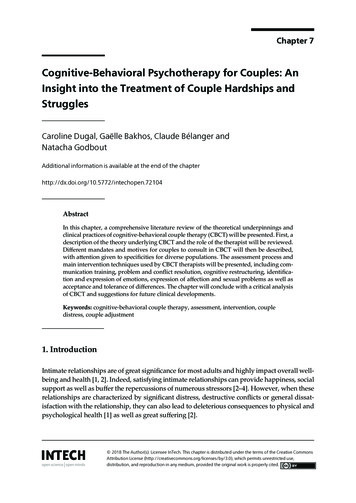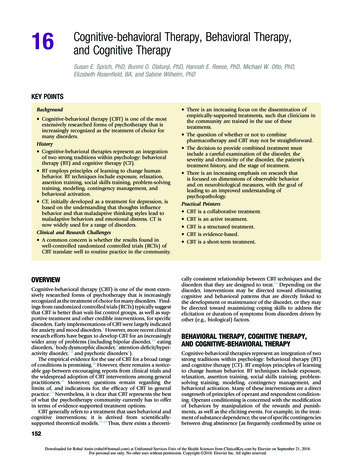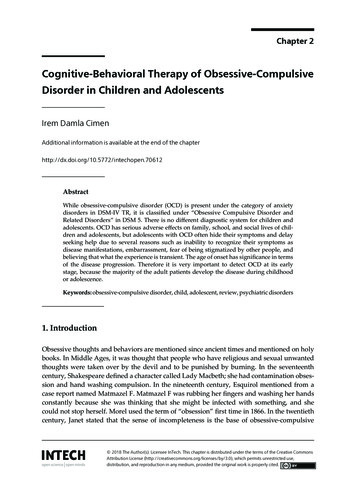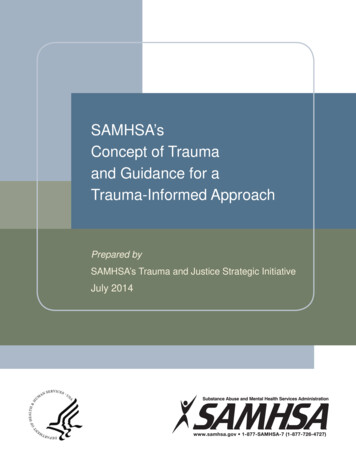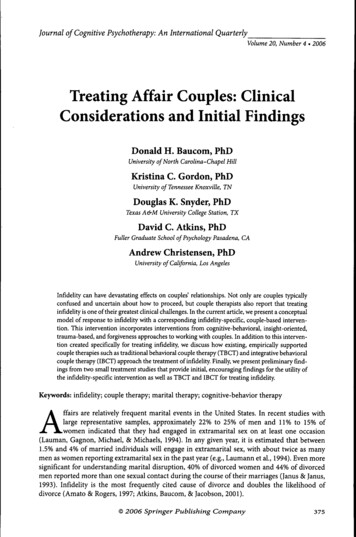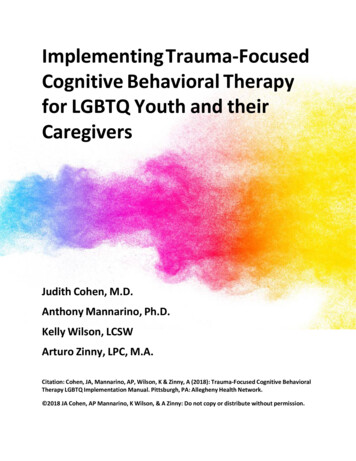
Transcription
Implementing Trauma‐FocusedCognitive Behavioral Therapyfor LGBTQ Youth and theirCaregiversJudith Cohen, M.D.Anthony Mannarino, Ph.D.Kelly Wilson, LCSWArturo Zinny, LPC, M.A.Citation: Cohen, JA, Mannarino, AP, Wilson, K & Zinny, A (2018): Trauma‐Focused Cognitive BehavioralTherapy LGBTQ Implementation Manual. Pittsburgh, PA: Allegheny Health Network. 2018 JA Cohen, AP Mannarino, K Wilson, & A Zinny: Do not copy or distribute without permission.
1TF‐CBT LGBTQ Implementation Manual Table of ContentsForward 2Introduction . . 4Integrating Family Acceptance Project’s (FAP) Family Support Model into TF‐CBT . 8FAP Section: Background Family Acceptance Project . . 9Assessment Strategies . . .10TF‐CBT Applications for Youth with Complex Trauma . .14FAP Section: Assessment . 17Enhancing Safety .20Psychoeducation .25 FAPSection: Psychoeducation . . . . .29 ParentingSkills . . .33Relaxation Skills . . . 37Affective Modulation Skills . .39Cognitive Coping Skills . 41Trauma Narration and Processing . . . 44FAP Section: Parent Response to Trauma Narrative . . .48In vivo Mastery . 49Conjoint Sessions . 51Enhancing Safety—Continued . .53Summary . . . .54References . .55Appendices . 58Appendix 1: TF‐CBT Brief PRACTICE Checklist Addendum for LGBTQ Youth . 59Appendix 2: Family Acceptance Project ‐ Resources & Materials . .65Appendix 3: Family Acceptance Project ‐ Youth Questionnaire . .67FAP Youth Support Map . . . . 73FAP Youth Gender Scale . . 74Appendix 4: Family Acceptance Project ‐ Parent Questionnaire . .75FAP Parent Support Map . . . . .81FAP Parent Gender Scale . . . .82
2FORWARDThis manual addresses strategies for implementing an evidence‐based youth trauma treatment—Trauma‐Focused Cognitive Behavioral Therapy (TF‐CBT)—for trauma‐impacted lesbian, gay, bisexual,transgender, queer/questioning and gender diverse (LGBTQ) youth. The information in this manual wasdeveloped through a National Child Traumatic Stress Network (NCTSN, www.nctsn.org) LearningCommunity, initiated through an NCTSN grant from the Substance Abuse and Mental Health ServicesAdministration (SAMHSA) to Allegheny General Hospital’s Center for Traumatic Stress in Children andAdolescents. The Learning Community included 32 members from 12 organizations, listed below.Clinicians presented TF‐CBT cases during bimonthly calls and provided de‐identified data for assessment,after which all participants shared resources about TF‐CBT implementation for LGBTQ youth and familiesand discussed how the TF‐CBT model should be modified to incorporate sexual orientation and genderidentity issues.All participants had previously received TF‐CBT basic training, and had a working knowledge of how toimplement the TF‐CBT model for typical treatment cases. The goal of this project was to then apply thatknowledge for traumatized LGBTQ youth and their parents or caretaking adults. Users of thisimplementation manual are similarly assumed to have a working knowledge of the basic TF‐CBTtreatment model and principles (Cohen, Mannarino & Deblinger, 2017) and of how the model isimplemented for youth with complex trauma (e.g., Cohen, Mannarino, Kliethermes & Murray, 2012).We strongly recommend that therapists complete initial web‐based TF‐CBT training (available athttps://tfcbt2.musc.edu), and face‐to‐face TF‐CBT training and consultation calls provided by anapproved TF‐CBT national trainer (https://tfcbt.org/training) prior to implementing the TF‐CBT LGBTQapplications described in this manual.”Special thanks and gratitude to Kelly Kinnish, Ph.D. (Georgia Center for Child Advocacy, Atlanta) andArturo Zinny, LPC, MA (Healing Hurt People, Drexel University, formerly PACTS, Philadelphia), whocoordinated with participating programs in their respective communities; Kelly Wilson, LCSW (NCTSNAffiliate member), who generously provided a web‐based platform and technological expertise to theLearning Community; and Jennifer Grady, MSSW (Duke University National Center for Child TraumaticStress), who provided coordination with the National Center for Child Traumatic Stress (NCCTS) andNCTSN sites throughout the project. We also thank Cathryn Chiesa of the Duke National Center for ChildTraumatic Stress, for conducting a research literature search discussed on page 6. We are very gratefulfor the expert review and comments provided by Antonia Barba, LCSW and Andrew Weinberg, LCSWthat greatly improved the manual. We also are very grateful to Antonia Barba, LCSW for creating theAddendum to the TF‐CBT Brief PRACTICE Checklist that appears as Appendix 1 in this manual.Finally, we are enormously grateful for and acknowledge the significant contributions of Caitlin Ryan,Ph.D., ACSW, Director of the Family Acceptance Project (FAP) at San Francisco State University(https://familyproject.sfsu.edu), who collaborated with us to integrate FAP’s research findings andintervention approaches from FAP’s family support model into this implementation manual. We alsowant to acknowledge Antonia Barba’s work with Dr. Ryan to align FAP and TF‐CBT’s models tostrengthen families and improve outcomes for LGBTQ youth.
3The following individuals participated in the TF‐CBT LGBTQ Learning Community (listed alphabetically byprogram). We thank all of these participants and the trauma‐impacted LGBTQ youth and families whohave received TF‐CBT treatment, from whom we have learned so much and who have made thisImplementation Manual possible.Allegheny General Hospital, Pittsburgh: Judith Cohen, M.D.; Anthony Mannarino, Ph.D.Center for Safe and Healthy Children, Atlanta: Jordan Greenbaum, M.D.Chris 180, Atlanta: Tharyn Grant, LCSWDevereux Georgia: Mike Cudmore, LPC; Rachel McEwan, LPC; Amy Waldron, LPCFamily Services Rhode Island, Providence: Kayla David, LPCFamily Ties, Atlanta: Tinika Prince, MA, NCC, LAPCGeorgia Center for Child Advocacy: Rebecca Ahmedi, LCP; Jennifer Hossler, MSW; Maggie Huddle,LMSW; Kelly Kinnish, Ph.D.; Keldric Thomas, Ph.D.; JaKarynn Conyers, LPCHall Mercer, Philadelphia: Lauren Cliggitt, MSW, LCSW; Gail Roeshman, LSW, MSW, M.Ed.Jewish Board of Family and Children’s Services, New York City: Antonia Barba, LCSW; Ellen Blaufox,LCSW‐R; Erin Mack, LCSWJoseph J. Peters Institute, Philadelphia: Caitlin Frett, MSJoy’us Beginnings, Atlanta: Sharnell Myles, PsyD, LPCNationwide Children’s Hospital, Columbus: Lourdes Hill, PCC‐S; Kynetta McFarlane, Psy.D.National Center for Child Traumatic Stress: Jennifer Grady, MSSWNational Child Traumatic Stress Network Affiliate, Madison: Kelly Wilson, LCSWPersad Center, Pittsburgh: Sandra Soloski, ; Andrew Weinberg, LCSWPhiladelphia Alliance for Child Trauma Services (PACTS): Arturo Zinny, LPC, MARady Children’s Hospital San Diego/Harvey Institute: Al Killen‐Harvey, LCSWServing Children and Adults in Need (SCAN‐Inc.), Laredo: Susana Rivera, Ph.D., LPCThe Village, Philadelphia: Paula Wood, MSW, LCSW; Robin Young, MSW, LSW
4INTRODUCTIONLesbian, gay, bisexual, transgender, queer/ gender diverse (LGBTQ) youth, as well as those who arequestioning their identity, experience the same types of traumas as other youth (e.g., childmaltreatment, domestic and community violence, motor vehicle accidents, natural disasters, traumaticdeath and separation, etc.). For brevity and consistency, throughout this manual we will use the term“youth” to refer to children and teens, recognizing that this treatment manual will be used to treatLGBTQ children as young as 3 years old, to transition age youth in their early 20’s; and that parents thinkof their offspring as “children” regardless of their age. We use LGBTQ as an umbrella term, includingdiverse sexual orientations and gender identities, understanding that not all words used to self‐identifyare included in this acronym; however, for the sake of consistency across research and literature we useit as a general term. We note here that other identities not explicitly listed here (e.g., pansexual,genderfluid, gender non‐binary, etc.) are still included in this material. We also note here thatterminology in the field of sexual orientation and gender identity is continuously evolving and thatdifferent cultures and individuals may prefer different terminology (Turban & Ehrensaft, 2017).Throughout this manual we use the term “gender diverse” except when specific studies used differentterminology (in which case we use the terminology used in that study). However, individual youth mayprefer different terms to identify themselves and therapists should use the individual youth’s preferredterminology and pronouns.LGBTQ youth are also at elevated risk for experiencing additional traumas that are specifically or in partrelated to their sexual orientation and/or gender identity. Despite their personal strength, resiliencyand courage to face adversity, this places LGBTQ youth at significantly greater risk for cumulativetrauma exposure—and for developing the negative mental health and medical sequelae that areassociated with multiple traumatic experiences.For example, according to the Gay, Lesbian Straight Education Network (Kosciw, 2017, et al.) 2017School Environment Survey (www.glsen.org): Almost 90% of LGBTQ youth report being harassed in school related to their sexualorientation or gender identityAlmost 30% of these students reported being physically harassed at school because oftheir sexual orientation; roughly 25%reported being physically harassed at school due totheir gender identityAbout one in four LGBTQ students reported having been physically assaulted at schoolduring the past year, primarily due to sexual orientation, gender identity and/orexpressionMore than 50% of LGBTQ students reported having been sexually harassed in the pastyearThe 2015 Youth Risk Behavior Survey (YRBS, http://www.cdc.gov/yrbs) documented that, compared tostraight youth, LGB youth reported significantly higher prevalence of: Bullying at school (LGB: 34.2% vs. straight: 18.8%)Electronic bullying (LGB: 28.0 % vs. straight: 14.2 %)Being forced to have sexual intercourse (LGB: 17.8% vs. straight: 5.4%)Experiencing sexual dating violence (LGB: 22.7% vs. straight: 9.1%)(Note: This study did not inquire about gender identity.)
5Additional traumas that LGBTQ youth may experience related to their sexual orientation, genderidentity and/or expression include: Hate crimesPolice or community identity‐based violenceParental rejecting behaviors that constitute emotional and physical abuse based onthe youth’s sexual orientation and/or gender identity and expression, often referredto as parental or family rejection (Ryan, 2009; Ryan, 2019c).The YRBS and GLSEN surveys also documented negative mental health outcomes in LGBTQ youth.Unfortunately, neither of these studies was able to include assessment of disorders such asPosttraumatic Stress Disorder (PTSD) or depression, nor to establish causality between trauma exposureand the reported problems. However, both surveys documented elevated risks for sadness, suicidalityand substance use among LGBTQ youth.For example, the YRBS documented that, compared to straight youth, LGB youth reported significantlyhigher prevalence of: Using alcohol (LGB: 40.5%; straight: 32.1%)Using marijuana (LGB: 32%; straight: 20.7%)Feeling sad or hopeless (LGB: 60.4%; straight: 26.4%)Seriously considering suicide (LGB: 42.8%; straight: 14.8%)Attempted suicide (LGB: 29.4%; straight: 6.4)A recent population‐based analysis of 2017 YRBS data from 10 states and 19 large urban school districtson the experiences of transgender students (Johns, Lowry, Andrzejewski, et al., 2019) found that: Nearly 2% of students in grades 9‐12 identified as transgenderA significantly higher percentage of transgender students reported violence andvictimization experiences compared with cisgender studentsA significantly higher percentage of transgender students reported lifetime use of allsubstances (except marijuana) compared with cisgender studentsA much higher percentage of transgender students reported suicidal thoughts andbehaviors compared with cisgender students:o Felt sad or hopeless: 53% of transgender students vs. 20.7% of cisgendermales and 39.3% of cisgender femaleso Considered attempting suicide: 43.9% of transgender students vs. 11% ofcisgender males and 20.3% of cisgender femaleso Made a suicide plan: 39.3% of transgender students vs. 10.4% of cisgendermales and 16% of cisgender femaleso Attempted suicide: 34.6% of transgender students vs. 5.5% of cisgender malesand 9.1% of cisgenderAlthough LGBTQ youth are typically compared to straight youth in these studies, it is important torecognize how stigma, trauma and mental health disparities may differentially impact youth dependingon their individual sexual orientation and/or gender identity. Some data suggest that bisexual andtransgender youth are at even higher risk than gay or lesbian youth for experiencing stigma, trauma,and/or health disparities specific to their sexual orientation and/or gender identity.
6Studies suggest that significant numbers of bisexual youth feel invisible (referred to as “bisexualinvisibility” or “bisexual erasure”) and stigmatized by gay and lesbian as well as by straight peers(“double discrimination”), including being stigmatized for being “promiscuous,” “unable to commit”and/or for having problems with relationships (San Francisco Human Rights Commission, 2011; HRCFoundation, 2014). These youth may also feel pressure to “choose” between a straight or gay identity,(i.e., their authentic bisexual identity is questioned or invalidated), and report being less aware thanlesbian or gay youth of safe spaces, supportive peers, accepting adults, or organizations that could helpthem related to their sexual identity issues (HRC Foundation, 2014). This study also found that bisexualyouth were less likely than gay or lesbian youth to report that they were “happy” or to be out to familyand friends. A recent study showed that for gay and lesbian youth, relationship involvement led to loweremotional distress, but for bisexual youth, relationship involvement led to higher emotional distress(Whitton, et al., 2018). This may be related to results from the National Intimate Partner Violence andSexual Violence Survey 2010 Findings on Victimization by Sexual Orientation, which documented thatbisexual women had significantly higher lifetime prevalence of experiencing rape and sexual violence byintimate partners and by any perpetrator than either straight or lesbian ISVS SOfindings.pdf). In their work with religiouslyconservative families with LGBT children, the Family Acceptance Project found that bisexual youthexperience high levels of pressure from parents to repress or reject their bisexual identity and manyhide their identity to decrease family conflict which increases isolation, depression and suicidality (Ryan,unpublished data).These studies highlight some of the differences within the LGBTQ umbrella, and the importance ofunderstanding the individual youth’s risks for stigma, trauma and behavioral health disparities.Two national studies found significantly higher rates of PTSD among LGBTQ individuals than among theirstraight and cisgender peers. Russell & Fish (2016) documented a 12‐month PTSD prevalence of 11.3%among 16‐20‐year‐old LGBTQ youth, compared to a national annual youth prevalence of 3.9%. Robertsand colleagues (2012) found that LGB young adults were at greatly increased risk for lifetime probablePTSD relative to other young adults, mostly due to higher rates of child abuse. Several studies haveshown relationships between various traumatic experiences and the development of PTSD in LGB youthpopulations, including statistically significant associations between bullying and PTSD (Beckerman &Auerbach, 2014); physical victimization and PTSD (D’Augelli et al., 2006); and sexual orientation‐relatedverbal or physical victimization and PTSD (Dragowski et al., 2011). Roberts et al (2012) documented thatamong a large national sample of young adults, the heightened risk for PTSD largely stemmed fromincreased risk of childhood sexual, physical and/or psychological abuse, which in turn was significantlypredicted by childhood gender diversity. Smith and colleagues (2016) found that among minority LGByouth, the risk of attempted suicidality was predicted by an interaction of PTSD, depressive andsubstance abuse symptoms. All of these studies emphasize the importance of assessing youth fortrauma exposure and symptoms, sexual orientation and gender identity as well as the full range ofmental health problems; and of providing effective, culturally appropriate trauma‐focused treatment toyouth who have significant trauma‐related problems.Historically, services for LGBT youth focused on protecting them from harm, including from parents whowere perceived as rejecting and being unable to learn to support their LGBTQ children (Ryan, 2014). As aresult, services typically were provided to LGBT youth individually or via peer support, but rarelyincluded parents (Ryan, 2014; Substance Abuse and Mental Health Services Administration ‐ SAMHSA,2014). The Family Acceptance Project was founded nearly 20 years ago (Ryan, 2014; SAMHSA, 2014) toestablish the field of family intervention with LGBTQ children and youth. FAP’s research hasdocumented the often‐critical role of families both in contributing to major health and mental health
7risks, and helping to protect LGBTQ youth from harm, and promoting their well‐being. FAP’s familysupport model helps practitioners to proactively engage and help families, particularly those who areambivalent or rejecting of their youth’s LGBTQ identity and gender expression—to understand howthese reactions contribute to their children’s health risks and how supportive behaviors can help tostrengthen their family and increase their child’s well‐being. The goal of FAP’s family support approachis not to change families’ deeply held beliefs or values, but rather, to align with the families’ values tosupport their LGBTQ children and to reduce the risks of their rejecting behaviors on their children’ssafety, health and well‐being (Ryan & Diaz, 2011; SAMHSA, 2014).TF‐CBT and the Family Acceptance Project are both strengths‐based, resiliency‐building approaches thatview the family and, in particular, the parent or caregivers as potential sources of support for the youth.Both models view cultural values as strengths that the therapist should try to learn about, respect andincorporate into treatment (Cohen, Mannarino & Deblinger, 2017; Ryan, 2014, SAMHSA, 2014). Coreassumptions of FAP’s approach are consistent with the TF‐CBT model and include the following (Ryan &Diaz, 2011): Most parents love their children and want them to be healthy and happy; however, their hopesand aspirations for their children are influenced by their culture, religious beliefs and othervalues that may be at odds with their child’s sexual orientation and/or gender identity.The therapist should strive to meet the family where they are, by starting at the parents’ currentlevel of knowledge, attitudes, expectations and beliefs about their child’s sexual orientationand/or gender identity. FAP’s framework provides a resiliency‐focused, strengths‐basedapproach that supports parents’ needs to be heard and understood from the perspective oftheir culture, values, beliefs and faith traditions. For many parents and caregivers, this is theirfirst experience being able to share their hopes, fears and concerns for their LGBTQ child in aconfidential interaction with an empathic nonjudgmental listener.Parents who are perceived as rejecting of their LGBTQ children are usually motivated by careand concern to help their children fit in, be accepted by others, be socialized into their culturalworld, and be successful in a hetero‐normative society that often victimizes, stigmatizes andharms individuals due to their sexual orientation and/or gender identity.Practitioners use FAP’s research findings, research‐based resources and framing to educateparents about how specific family rejecting behaviors impact their LGBTQ child’s health andmental health risks and how supportive and accepting behaviors help protect against risk andpromote positive outcomes and well‐being (Ryan, 2009; Ryan, 2014; Ryan, 2019a, 2019b, 2019c;SAMHSA, 2014).Many parents experience their children’s sexual orientation and/or gender identity as pullingtheir child away from the family and as a loss and/or loss of control over their children’s positivefuture. Practitioners should understand that parents experience their lack of knowledge orunderstanding of their children’s sexual orientation and/or gender identity as inadequacy thatfeels disempowering and shameful. It is very helpful for practitioners to recognize, validate andaddress these feelings, and emphasize the importance of parental support during TF‐CBT asdescribed in this implementation manual.FAP’s research found that the largest proportion of parents and caregivers are ambivalent abouttheir child’s LGBTQ identity, followed by rejecting and then accepting families. When rejectingand accepting behaviors coexist, the resulting ambivalence causes parents to struggle to supporttheir LGBTQ children, leading to increased risk. Education about how family reactions impactLGBTQ youth can improve communication and help parents to better support their LGBTQyouth.
8Evidence‐based psychotherapies such as Trauma‐Focused Cognitive Behavioral Therapy (TF‐CBT) are thefirst line treatment for youth with PTSD and related difficulties (AACAP, 2010). However, treatment mustbe tailored to meet cultural, developmental, family and individual needs. This implementation manualprovides therapists who are treating trauma‐impacted LGBTQ youth with information about how toimplement TF‐CBT with appropriate modifications in order to facilitate optimal LGBTQ youth recoveryfrom trauma.Since TF‐CBT includes parents or other primary caregivers in treatment whenever possible, this manualalso addresses the often‐critical issues of enhancing parental acceptance and support of traumatizedLGBTQ youth, incorporating the seminal findings, research‐based resources and family supportstrategies from the Family Acceptance Project (Ryan, 2014). See the FAP section below for additionalinformation on the Family Acceptance Project’s background and aims. For brevity the term “parent” isused throughout this manual, recognizing that often the primary caregiver for LGBTQ youth whom thetherapist is trying to engage in TF‐CBT will not be a birth parent but another adult (e.g., grandparent,aunt or uncle, older sibling, foster/adoptive parent, etc.).Moreover, because FAP interventions may be implemented by a variety of individuals (e.g., nurses,teachers, parent support partners, or parents themselves), the FAP sections in this manual refer to“practitioners” rather than “clinicians.Integrating Family Acceptance Project’s Family Support Model into TF‐CBT for LGBTQ YouthWe collaborated with the Family Acceptance Project to include FAP components and procedures in thismanual for several reasons. We have followed FAP’s research and the development of their familysupport model with great interest since their initial research was published. TF‐CBT does not includeperpetrating caregivers in treatment, and we emphasize that this is still the case for caregivers who haveperpetrated sexual or physical abuse. However, FAP’s research has indicated that transforming familydynamics and increasing affirmation and acceptance can potentially improve depression, suicidality andother trauma‐related responses experienced by LGBTQ youth. Based on FAP’s research and interventionwork, we have modified TF‐CBT to include rejecting parents (i.e., those who have been emotionallyabusive related to their children’s sexual and/or gender identity) in TF‐CBT, in situations where thetherapist determines that this is clinically appropriate. In cases where the parent’s behavior becomesactively unsafe or physically harmful to the child, therapists should take necessary steps to ensure theirsafety including limiting or concluding the parent’s involvement in treatment, involving alternateaffirming caregivers, or pausing TF‐CBT treatment to implement the FAP model, Alternatives for Families:A Cognitive Behavioral Therapy (AF‐CBT, www.afcbt.org ) or other interventions that also work withperpetrating caregivers.Moreover, we saw the synergy between these two intervention models and the significant benefits ofintegrating them. To assist therapists interested in expanding their treatment to include FAPinterventions, we have inserted FAP implementation sections at the end of several TF‐CBT componentsand included several FAP resources in the appendix. They contain strategies and tools that therapistsmay consider for inclusion in work with trauma‐impacted youth and their caregivers. Therapists shoulduse their best clinical judgment when selecting interventions and utilize those that are most aligned withtheir clients’ experiences and trauma treatment goals, that have the potential to strengthen the parent‐child relationship, and promote youths’ safety and well‐being. Our pilot data from the TF‐CBT LGBTQLearning Community are promising and suggest the positive impact of integrating aspects of the TF‐CBTand FAP models to improve PTSD symptoms for LGBTQ youth. We hope to continue to build on thissynergy as TF‐CBT clinicians apply this work with LGBTQ youth and families.
9FAP Section#INTRODUCTION[ 2018 Caitlin Ryan – Excerpted from: Ryan, C. (2018). Family Acceptance Project: Working Procedures. SanFrancisco: Family Acceptance Project]Family Acceptance Project – Helping Diverse Families to Support & Affirm Their LGBTQ ChildrenThe Family Acceptance Project (FAP) is a research, education, intervention and policy initiative that was developedby Caitlin Ryan, PhD and Rafael Diaz, PhD in 2002 to help families learn to support their LGBTQ children to reducehealth risks and promote well-being in the context of their families, cultures and faith communities. FAP’s workincludes the first comprehensive research on LGBTQ youth and families and the first evidence-informed familysupport model that FAP developed for use in educational and treatment approaches for prevention, wellness andcare for LGBTQ children and adolescents (Ryan, 2014).FAP’s family support model is grounded in participatory mixed methods research that studied LGBTQ youth andfamilies in their homes and communities. Among other findings, FAP researchers identified more than 100 specificbehaviors that parents and caregivers use to express rejection and acceptance of their LGBTQ children andmeasured how these behaviors contribute to health risks and well-being. FAP worked with diverse families andLGBTQ youth to develop intervention strategies and research-based resources to help families to decrease rejectionand increase support and acceptance for their LGBTQ children. These strategies and resources can be integratedinto TF-CBT to support recovery and help reduce risk and promote well-being for LGBTQ children and youth whetheror not the child’s LGBTQ identity is trauma-related. Moreover, FAP believes that TF-CBT treatment with LGBTQchildren and youth will be enhanced and family relationships will be strengthened when practitioners apply FAP’sfamily support approach and resources with all families with LGBTQ children.All LGBTQ children benefit from family support and even parents and caregivers that are perceived as acceptingneed to understand how to care for and learn to advocate for their LGBTQ children in the family and in their child’ssocial world. Because most families don’t know about FAP’s research and how family responses and behaviors affecttheir LGBTQ children’s risk and well-being, many caregivers assume that telling their LGBTQ child they love them orgiving them a hug is all their child needs to experience affirmation and validation of their sexual orientation andgender identity. These caregivers may see themselves as accepting while the youth routinely experiences theirparent’s ambivalence and lack of support, and wonders if their parent will be there for them when they really needthem. Routinely, LGBTQ youth will tell FAP practitioners, “I think my parent cares about me but they don’t knowanything about my LGBTQ friends, if I have a partner, what I do in the community or at school. They never talk aboutmy LGBTQ identity. So no, they don’t accept me.” These feelings are expressed empirically in FAP’s research whereLGBTQ young people whose parents and caregivers who are moderately rejecting or ambivalent are more than threetimes as likely to report high levels of depression and twice as likely to attempt suicide compared with LGBTQ peerswho report no or low family rejecting behaviors (see Ryan, 2009 for multilingual family education
2 FORWARD This manual addresses strategies for implementing an evidence‐based youth trauma treatment— Trauma‐Focused Cognitive Behavioral Therapy (TF‐CBT)—for trauma‐impacted lesbian, gay, bisexual,






